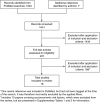The burden of invasive pneumococcal disease in children with underlying risk factors in North America and Europe
- PMID: 23869711
- PMCID: PMC4232238
- DOI: 10.1111/ijcp.12234
The burden of invasive pneumococcal disease in children with underlying risk factors in North America and Europe
Abstract
Background: Characterisation of risk groups who may benefit from pneumococcal vaccination is essential for the generation of recommendations and policy.
Methods: We reviewed the literature to provide information on the incidence and risk of invasive pneumococcal disease (IPD) in at-risk children in Europe and North America. The PubMed database was searched using predefined search terms and inclusion/exclusion criteria for papers reporting European or North American data on the incidence or risk of IPD in children with underlying medical conditions.
Results: Eighteen references were identified, 11 from North America and 7 from Europe, with heterogeneous study methods, periods and populations. The highest incidence was seen in US children positive for human immunodeficiency virus infection, peaking at 4167 per 100,000 patient-years in 2000. Studies investigating changes in incidence over time reported decreases in the incidence of IPD between the late 1990s and early 2000s. The highest risk of IPD was observed in children with haematological cancers or immunosuppression. Overall, data on IPD in at-risk children were limited, lacking incidence data for a wide range of predisposing conditions. There was, however, a clear decrease in the incidence of IPD in at-risk children after the introduction of 7-valent pneumococcal conjugate vaccine into immunisation programmes, as previously demonstrated in the general population.
Conclusion: Despite the heterogeneity of the studies identified, the available data show a substantial incidence of IPD in at-risk children, particularly those who are immunocompromised. Further research is needed to determine the true risk of IPD in at-risk children, particularly in the post-PCV period, and to understand the benefits of vaccination and optimal vaccination schedules.
© 2013 The Authors. International Journal of Clinical Practice published by John Wiley & Sons Ltd.
Figures
Comment in
-
Invasive pneumococcal disease in children: cross-disciplinary frameworks.Int J Clin Pract. 2014 Jan;68(1):2-3. doi: 10.1111/ijcp.12273. Int J Clin Pract. 2014. PMID: 24341296 No abstract available.
References
-
- O'Brien KL, Wolfson LJ, Watt JP, et al. Burden of disease caused by Streptococcus pneumoniae in children younger than 5 years: global estimates. Lancet. 2009;374:893–902. - PubMed
-
- World Health Organisation. Pneumococcal vaccines. WHO position paper - 2012. Wkly Epidemiol Rec. 2012;87:129–44. - PubMed
-
- De Carvalho Gomes H, Muscat M, Monnet DL, Giesecke J, Lopalco PL. Use of seven-valent pneumococcal conjugate vaccine (PCV7) in Europe, 2001-2007. Euro Surveill. 2009;14 . pii: 19159. - PubMed
-
- Nuorti JP, Whitney CG. Prevention of pneumococcal disease among infants and children - use of 13-valent pneumococcal conjugate vaccine and 23-valent pneumococcal polysaccharide vaccine - recommendations of the Advisory Committee on Immunization Practices (ACIP) MMWR Recomm Rep. 2010;59:1–18. - PubMed
Publication types
MeSH terms
LinkOut - more resources
Full Text Sources
Other Literature Sources
Medical


